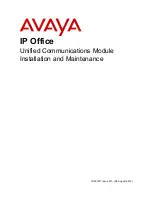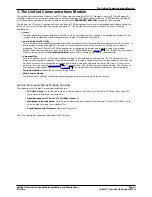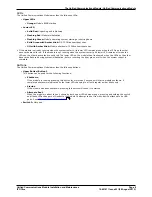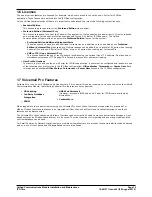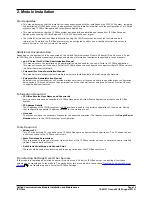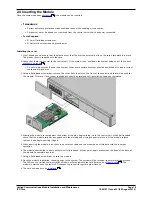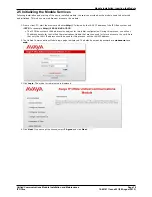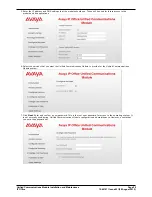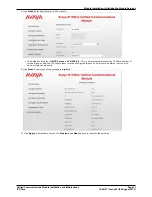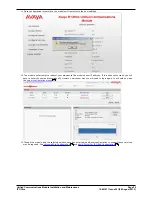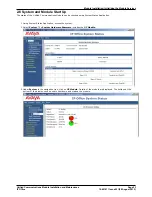
Unified Communications Module Installation and Maintenance
Page 11
15-601011 Issue 03l (28 August 2012)
IP Office
The Unified Communications Module: Additional Documentation
1.4 Network Configuration Limitations
The IP Office control unit has two physical LAN interfaces: LAN1 and LAN2. The ports labeled LAN and WAN respectively.
Traffic between the IP Office control unit and the Unified Communications Module is on LAN1 of the IP Office system.
Scenarios where users of the Unified Communications Module applications, especially one-X Portal for IP Office, are
accessing the IP Office and thus the Unified Communications Module via the IP Office system's LAN2 (WAN) port should be
avoided for more than 30 users.
They should also be avoided where NAT is being applied to traffic between LAN1 and LAN2. These restrictions should be
observed even when the IP Office system is in a Small Community Network where the H323 SCN trunks may be routed via
the other LAN.
1.5 Small Community Networks
Up to 32 IP Office systems can be connected together using H323 SCN trunks to form a Small Community Network,
supporting up to 1000 users. The servers in the system automatically share information about users and other features in
order to act as a single system.
·
The Unified Communications Module is only supported as an application server for a Small Community Network of
up to 6 systems. It is also limited to supporting only 200 users if it is running the one-X Portal for IP Office
application.
When installing a Unified Communications Module within a Small Community Network, it is important to be aware of the
following factors affecting the different server applications:
·
one-X Portal for IP Office
Only a single instance of the one-X Portal for IP Office application is supported within a Small Community Network.
·
When run on a Unified Communications Module, one-X Portal for IP Office is only supported for up to 200 users
and 50 simultaneous sessions. To support more users and sessions (500), the one-X Portal for IP Office
application needs to be installed on a separate server from the Unified Communications Module.
·
Following installation of the Unified Communications Module with one-X Portal for IP Office application on it,
addition configuration steps are required to configure the one-X Portal for IP Office application with details of
the other IP Office systems. This addition configuration is covered in the one-X Portal for IP Office Installation
Manual.
·
Voicemail Pro
In an Small Community Network, one Voicemail Pro server is used to store all mailboxes and their related
messages, greeting and announcements. This is referred to the centralized voicemail server. However, additional
Voicemail Pro servers can be installed to perform some other specific roles as listed below. Full details of the setup
for these roles is covered in the Voicemail Pro manuals.
·
Centralized Voicemail Server
In the network, one Voicemail Pro server is used as the centralized voicemail server for all IP Office systems in
the network. This server is used to store all mailboxes and their related messages, greeting and
announcements. This is mandatory regardless of the presence of any additional options below. The IP Office
associated with the centralized server holds the licenses for voicemail server support. The other servers in the
network do not require any voicemail licenses in order to use this server as their voicemail server.
·
Fallback IP Office
Without needing to install another Voicemail Pro server, the IP Office hosting the centralized voicemail
server can be configured such that, if for any reason it is stopped or disabled, the centralized voicemail
server switches to being controlled by another IP Office in the network.
·
Distributed Voicemail Servers
Additional Voicemail Pro servers can be installed and associated with other IP Office systems to provide call
services for that system. For example to record messages, play announcements, etc. However, any messages
it records are then automatically transferred to and stored on the centralized server. The IP Office associated
with the distributed server requires the appropriate licenses for voicemail server support.
·
Backup Voicemail Server
An additional sever, with the Voicemail Pro application can be specified as the backup server for the centralized
server. If for any reason the voicemail application on the centralized server is stopped or disabled, the
centralized IP Office will switch to using the backup voicemail server for its voicemail functions. During normal
operation the centralized and backup voicemail servers automatically exchange information about mailboxes
and voicemail service configuration. The backup voicemail server uses the licenses provided by the centralized
IP Office. A distributed server cannot also be used as a backup server and vice versa.

